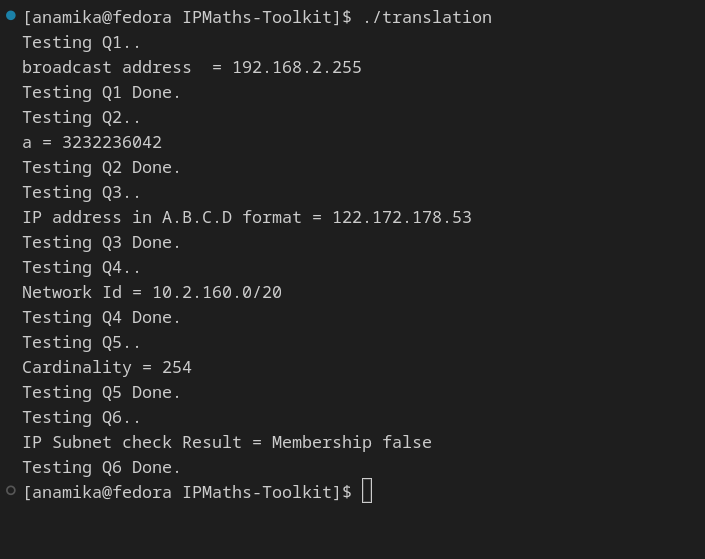🔧 A collection of C functions dedicated to IP address mathematics and manipulations. Dive deep into bitwise operations, subnetting, and other networking essentials. A hands-on approach to mastering IP calculations for budding system programmers. 💻
This is all about diving deep into the world of IP addresses. Before we move on, ensure you have a solid understanding of bitwise operations in C, as well as the left and right shift operations. Let's get started!
+--------------------------------------------------+
| IP Address Calculator |
+---------+--------+--------+---------+--------+----+
| Task1 | Task2 | Task3 | Task4 | Task5 |...|
+---------+--------+--------+---------+--------+----+
| Compute | Compute| Convert| Convert | Compute|...|
| Mask |Broadcst| IP2Int | Int2IP | Network|...|
| Int | Address| | | ID |...|
+---------+--------+--------+---------+--------+----+
| Task6 | Task7 |
+---------+-------------------------------------------+
| Subn. | Check IP Subnet Membership |
| Hosts | |
+---------+-------------------------------------------+
- This will help you harness the power of bitwise manipulation, especially when it comes to networking.
- Mastery over IP address mathematics from this module.
- Bitwise operations (AND, OR) and shifts (left, right) in C.
- Ensure you have a GCC compiler. And it's recommended to run this on Linux.
Function: get_mask_value_in_integer_format(char mask_value)
- Logic Breakdown:
- Initialization 🏁: Start with a mask where all bits are set to 1 (
0xFFFFFFFF). This ensures we have a full 32-bit mask representation. - Calculate unset bits 💻: Subtract the mask value from the maximum possible mask value (32) to determine the number of trailing zeros.
- Loop to unset bits 🔁: Iterate through the number of bits to unset, and at each iteration, unset the bit at the current position.
- Initialization 🏁: Start with a mask where all bits are set to 1 (
Function: get_broadcast_address(char *ip_addr, char mask, char *output_buffer)
- Logic Breakdown:
- Convert IP to integer ➡️: Convert the string format of the IP address to an integer format.
- Fetch integer representation of mask 🎭: Retrieve the integer representation of the provided mask.
- Compute complement 🔄: Invert the mask's bits to obtain the broadcast address's portion.
- OR operation ➕: OR the integer IP with the mask's complement. This gives the broadcast address.
- Convert back to string ➡️: Convert the resulting integer to a string format and store it in the output buffer.
Function: get_ip_integer_equivalent(char *ip_address)
- Logic Breakdown:
- Use
inet_ptonfunction to convert the IP's string format to its integer representation.
- Use
Function: get_abcd_ip_format(unsigned int ip_address, char *output_buffer)
- Logic Breakdown:
- Use the
inet_ntopfunction to convert the integer format of the IP back to its A.B.C.D string format.
- Use the
Function: get_network_id(char *ip_address, char mask, char *output_buffer)
- Logic Breakdown:
- Conversion to integer ➡️: Convert the IP's string format to its integer representation.
- AND operation ➕: Obtain the network ID by AND-ing the IP with the subnet mask.
- Conversion back to string ➡️: Convert the resulting integer back to its A.B.C.D string format.
Function: get_subnet_cardinality(char mask_value)
- Logic Breakdown:
- Compute host bits using
32 - mask_value. - Use (2^{\text{host bits}} - 2) to find valid hosts in the subnet.
- Compute host bits using
Function: check_ip_subnet_membership(char *network_id, char mask, char *check_ip)
- Logic Breakdown:
- Convert to integer ➡️: Convert both the provided network ID and the IP to check into integer formats.
- Compute network ID of the given IP 🌐: Find the network ID of the IP by AND-ing it with the subnet mask.
- Comparison
↔️ : Check if the calculated network ID matches the provided one.
Two handy links will guide you:
- Useful for IP address format conversions
- For double-checking network IDs, broadcast addresses, and the cardinality of subnets
It's wise to stick to a Linux environment.
To compile the program, navigate to the directory where the source code is stored and run the following command in the terminal:
gcc -o translation -lm translation.c./translationBelow is an explanation of each test scenario based on the sample output provided:
- Input: IP Address:
192.168.2.10, Subnet Mask:/24 - Output: Broadcast Address:
192.168.2.255 - Explanation: The broadcast address for the given subnet (
192.168.2.0/24) is192.168.2.255, which matches the output. This indicates the function is working as expected.
- Input: IP Address:
192.168.2.10 - Output: Integer Equivalent:
3232236042 - Explanation: The integer equivalent of the IP address
192.168.2.10is3232236042, which matches the output. The function appears to work correctly.
- Input: Integer:
2058138165 - Output: IP Address in A.B.C.D Format:
122.172.178.53 - Explanation: The IP address corresponding to the integer
2058138165is122.172.178.53, which is correct based on the output.
- Input: IP Address:
192.168.2.10, Subnet Mask:/20 - Output: Network ID:
10.2.160.0/20 - Explanation: The output for the network ID appears to be incorrect.(to do -- debug) Based on the input, it should have been
192.168.0.0/20.
- Input: Subnet Mask:
/24 - Output: Cardinality:
254 - Explanation: In a
/24subnet, there are256total addresses. Subtracting2for the network and broadcast addresses leaves254usable addresses, which matches the output.
- Input: Network ID:
192.168.1.0/24, IP Address to Check:192.168.1.10 - Output: Membership Result: "Membership false"
- Explanation: This output appears to be incorrect.(to do -- debug) The IP address
192.168.1.10should indeed belong to the192.168.1.0/24subnet.
🍀 Best of luck 🚀
